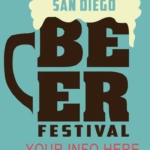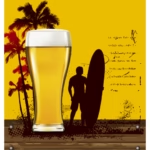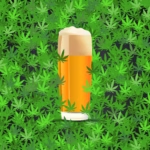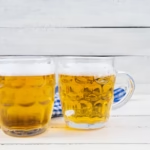Welcome, beer aficionados, to Brewery-Search.com’s deep dive into the frothy, fantastic history of beer! This isn’t just a drink—it’s a 9,000-year-old saga of human brilliance, happy accidents, and the occasional wobbly walk home. From Sumerian scribes toasting their beer goddess to American brewers concocting IPAs that taste like a tropical vacation, beer has been our trusty companion through pyramids, plagues, and Prohibition. So, grab a pint, kick back, and join us for a professional yet playful journey through the ages, packed with juicy details, quirky facts, and the story of how beer became the liquid legend we love today.
Mesopotamia: The Accidental Brew That Started It All (Circa 7000 BCE)
Our tale begins in ancient Mesopotamia, around 7000 BCE, in what’s now Iraq. Imagine a Sumerian farmer forgetting a bowl of barley in the scorching sun. Wild yeast, the ultimate freeloader, swoops in, ferments the soggy grains, and boom—beer is born. This proto-brew was a chunky, porridge-like concoction, likely tasting like sour bread soup. By 3000 BCE, Sumerians were so obsessed they etched beer recipes on clay tablets, including one for “Ebla beer,” a mix of barley, emmer wheat, and random herbs. They sipped it through reed straws to avoid the grit—think of it as the world’s first hazy IPA, minus the Instagram filter. The Sumerians even had a beer goddess, Ninkasi, whose “Hymn to Ninkasi” from 1800 BCE doubles as a brewing manual and a poetic banger. Fun Fact: Ninkasi’s hymn describes mashing dough and fermenting it in clay jars, proving that even ancient happy hours had recipes worth scribbling down.
Egypt: Beer as Life, Lunch, and Paycheck (Circa 3000 BCE)
Across the desert in ancient Egypt, beer wasn’t just a drink—it was a lifestyle. Called “heqet” or “zythum,” this thick, low-alcohol brew of barley or emmer wheat was the Gatorade of the Nile. Safer than river water, it was chugged by everyone—kids, farmers, even pharaohs. Pyramid builders got paid in jugs of it, with workers downing up to a gallon a day during construction of the Giza pyramids around 2500 BCE. Brewed by women in massive vats, heqet was flavored with dates, honey, or herbs like lupine, making it a sweet, funky staple. Egyptians took it so seriously they buried brewing kits in tombs for the afterlife, ensuring eternal buzzes. Fun Fact: Egyptian brewers used clay pots with tiny perforations to strain the mash, a technique so clever it’s basically the ancient version of a cold brew coffee maker.
Ancient China: Rice Beer and the Party Gods (Circa 7000 BCE)
While Mesopotamia was slurping barley brews, ancient China was getting in on the action with rice-based beer around 7000 BCE. Archaeological digs in Jiahu, Henan Province, uncovered 9,000-year-old pottery with traces of a fermented mix of rice, honey, and hawthorn fruit—think sake’s wilder, funkier cousin. These brews, likely used in rituals, were spiked with grapes or berries for extra zing. By the Shang Dynasty (1600–1046 BCE), beer was a sacred offering to ancestors, brewed in bronze vessels so ornate they make modern taprooms look basic. Fun Fact: The Jiahu brew is the oldest known fermented beverage, predating wine and suggesting humans were partying before we even invented the wheel.
Greece and Rome: Beer Takes a Backseat (500 BCE–400 CE)
In ancient Greece and Rome, wine stole the spotlight, with beer dismissed as the drink of “barbarians.” Still, the Greeks brewed “zythos,” a barley-based beer, and the Romans had “cervisia,” named after the Celtic grain goddess Ceres. These brews were popular in the provinces, especially among soldiers stationed in places like Britain and Gaul, where grapes were scarce. Roman writer Pliny the Elder sniffed that beer was “a high-class kind of dishwater,” but that didn’t stop Celtic tribes from perfecting their ales with local herbs. Fun Fact: The Roman term “cervisia” is the root of the Spanish word “cerveza,” proving beer’s linguistic legacy outlasted snobby emperors.
Medieval Europe: Monks, Hops, and the Rise of Real Beer (500–1500 CE)
By the Middle Ages, beer was Europe’s MVP, especially in regions like Germany and Belgium where water was dicey and wine was for rich folks. Monasteries became the craft breweries of their day, with monks brewing robust ales to sustain them through Lent—fasting doesn’t count if it’s liquid, right? Around the 10th century, German brewers discovered hops, those bitter, piney buds that preserved beer and gave it flavor beyond “fermented mud.” By the 13th century, hopped beers were spreading, and in 1516, Bavaria’s Reinheitsgebot purity law locked in the recipe: water, barley, hops (yeast came later, once science caught up). Monasteries like those in Belgium’s Trappist tradition churned out complex ales, some as strong as 10% ABV, making monks the original beer influencers. Fun Fact: The term “small beer” comes from medieval times, referring to weak, second-run brews given to kids and servants—basically the LaCroix of the Middle Ages.
Renaissance to Industrial Revolution: Beer Gets Scientific (1500–1800s)
The Renaissance brought better brewing tech, like copper kettles and early thermometers, letting brewers move beyond “hope and a prayer.” In England, the 1700s saw the rise of porters, dark, roasty beers named for the porters hauling goods in London’s bustling markets. These were the first beers aged in barrels, giving them a depth that made alehouses the place to be. The Industrial Revolution in the 1800s supercharged brewing with steam-powered breweries, precise temperature control, and glass bottles for portability. In 1842, the Czech town of Pilsen changed the game with the pilsner—a crisp, golden lager made with bottom-fermenting yeast and pale malt, thanks to new kilning tech. Pilsner was the Tesla of beers: sleek, scalable, and universally loved. By the late 1800s, brands like Anheuser-Busch and Heineken were scaling up, turning beer into a global juggernaut. Fun Fact: The first canned beer hit U.S. shelves in 1935, courtesy of Krueger’s Cream Ale, sparking a love affair with cans that’s still going strong.
America’s Beer Journey: From Lager to Prohibition to Craft (1800s–Present)
German immigrants brought lager expertise to America in the 1840s, turning cities like Milwaukee and St. Louis into beer hubs. Breweries like Pabst and Miller churned out crisp lagers for a growing nation. Then, in 1920, Prohibition slammed the brakes, outlawing alcohol and sending beer underground. Homebrewers and speakeasies kept the spirit alive, with bootleggers sneaking brews in barrels marked “syrup.” When Prohibition ended in 1933, macro breweries roared back, flooding the market with light lagers like Budweiser and Coors—affordable, consistent, but about as exciting as a plain bagel. By the 1970s, Americans wanted more. The craft beer revolution kicked off with Sierra Nevada’s Pale Ale in 1980, inspiring a wave of microbreweries. By 2025, the U.S. boasts over 9,000 craft breweries, crafting everything from grapefruit sours to stouts aged in bourbon barrels so potent they could wake a coma patient. Fun Fact: The term “IPA” (India Pale Ale) comes from the 1700s, when British brewers loaded beers with extra hops to survive long sea voyages to India—basically, hops were the OG preservatives.
The Science of Suds: How Beer Evolved
Beer’s magic comes down to four ingredients: malted grains (usually barley), soaked and roasted to release sugars; water, the unsung hero; hops, for bitterness and aroma; and yeast, the microbe that turns sugar into alcohol and carbonation. Ancient brewers mashed grains by hand, boiled them with whatever herbs they could scrounge, and relied on wild yeast. Medieval monks refined the process with wooden vats and early hops. Today, stainless steel tanks, lab-grown yeast strains, and precise brewing systems let brewers dial in flavors like never before. Modern craft brewers are like alchemists, tossing in coffee, vanilla, or even ghost peppers to create beers that taste like desserts, forests, or straight-up sorcery. Fun Fact: The discovery of yeast’s role in fermentation in the 1850s by Louis Pasteur revolutionized brewing, proving science and beer are the ultimate power couple.
Beer’s Enduring Legacy
Beer’s history is a wild, wobbly ride through human triumphs and flops. It fueled Egyptian workers, warmed medieval monks, and survived America’s dry spell. From Sumerian clay jars to American taprooms pouring triple IPAs, beer’s been there for every toast, tailgate, and “just one more” moment. In 2025, whether you’re cracking a lager at a barbecue or savoring a barrel-aged stout at a brewery, you’re part of a 9,000-year-old tradition. Here’s to the farmers, monks, and rebels who kept the brews flowing—and to you, for keeping the party alive. Cheers to beer, the drink that’s always got our back!





Leave a Reply